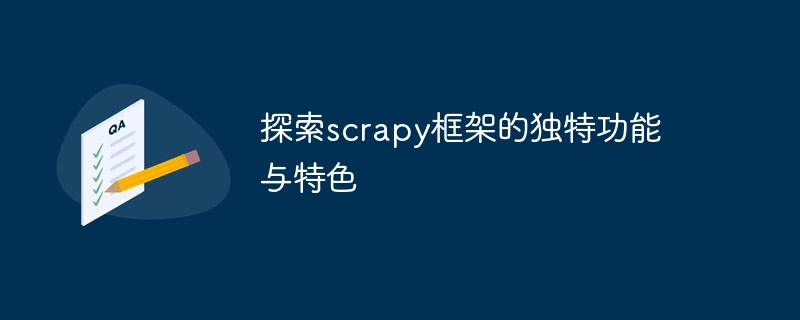Home >Backend Development >Python Tutorial >Explore the unique capabilities and features of the scrapy framework
Explore the unique capabilities and features of the scrapy framework
- PHPzOriginal
- 2024-01-19 09:39:13543browse

Explore the unique functions and features of the Scrapy framework
Introduction:
In modern web crawler development, choosing the right framework can improve efficiency and ease of use. Scrapy is a widely recognized Python framework. Its unique functions and features make it the preferred crawler framework for many developers. This article will explore the unique capabilities and features of the Scrapy framework and provide specific code examples.
1. Asynchronous IO
Scrapy uses the Twisted engine as the bottom layer, which has powerful asynchronous I/O capabilities. This means that Scrapy can execute multiple network requests at the same time without blocking the execution of other requests. This is useful for handling large numbers of network requests efficiently.
Code example one:
import scrapy
class MySpider(scrapy.Spider):
name = 'myspider'
start_urls = ['http://example.com/page1', 'http://example.com/page2', 'http://example.com/page3']
def parse(self, response):
# 解析响应数据
pass2. Distributed crawler
Scrapy supports distributed crawlers, which means that crawlers can be run on multiple machines at the same time. This is important for crawling data at scale and improving efficiency. Scrapy uses a distributed scheduler and deduplicator to ensure that crawling tasks are evenly distributed to multiple crawler nodes.
Code example two:
import scrapy
from scrapy_redis.spiders import RedisSpider
class MySpider(RedisSpider):
name = 'myspider'
redis_key = 'myspider:start_urls'
def parse(self, response):
# 解析响应数据
pass3. Automatic request scheduling and deduplication
The Scrapy framework comes with powerful request scheduling and deduplication functions. It automatically handles request scheduling and deduplication of crawled URLs. This can greatly simplify the writing and maintenance of crawlers.
Code example three:
import scrapy
class MySpider(scrapy.Spider):
name = 'myspider'
start_urls = ['http://example.com/page1', 'http://example.com/page2', 'http://example.com/page3']
def parse(self, response):
# 解析响应数据
pass4. Flexible data extraction and processing
Scrapy provides a rich and flexible mechanism to extract and process data in web pages. It supports XPath and CSS selectors to locate and extract data, and also provides additional data processing functions, such as removing html tags, formatting data, etc.
Code example four:
import scrapy
class MySpider(scrapy.Spider):
name = 'myspider'
start_urls = ['http://example.com/page1']
def parse(self, response):
# 使用XPath提取数据
title = response.xpath('//h1/text()').get()
content = response.xpath('//div[@class="content"]/text()').get()
# 使用CSS选择器提取数据
author = response.css('.author::text').get()
# 对数据进行处理
processed_content = content.strip()
# 打印提取的数据
print('Title:', title)
print('Author:', author)
print('Content:', processed_content)Conclusion:
The Scrapy framework’s asynchronous IO capabilities, distributed crawler support, automatic request scheduling and deduplication, flexible data extraction and processing, etc. are unique Its functions and features give it obvious advantages in web crawler development. Through the introduction and code examples of this article, I believe readers will have a deeper understanding of the characteristics and usage of the Scrapy framework. For more information and documentation about the Scrapy framework, please refer to the official website and community.
The above is the detailed content of Explore the unique capabilities and features of the scrapy framework. For more information, please follow other related articles on the PHP Chinese website!

